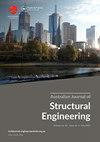受腐蚀钢结构疲劳寿命预测及维修管理
IF 1.3
Q4 ENGINEERING, CIVIL
Australian Journal of Structural Engineering
Pub Date : 2021-11-08
DOI:10.1080/13287982.2021.1999041
引用次数: 2
摘要
提出了一种预测钢结构疲劳和腐蚀失效的新方法。建立了一个模型来确定梁(即完整板)和连接在同时腐蚀和疲劳环境下的S-N曲线变化。然后将梁和连接的疲劳损伤建模为随机过程。采用一遍概率法确定了板和连接件疲劳失效的时变概率,并以某钢结构为例进行了系统可靠性分析。研究发现,忽略腐蚀对梁和连接S-N曲线的影响会导致对腐蚀钢结构疲劳寿命的低估。人们还发现,腐蚀的连接比梁更容易受到疲劳破坏。除此之外,还将风险成本优化程序应用于工作实例,以找到确保钢结构安全运行的维护策略,并打算将总风险降至最低。本文提出的方法可以帮助结构工程师和资产管理者对同时遭受腐蚀和疲劳的钢结构进行维修和维护。本文章由计算机程序翻译,如有差异,请以英文原文为准。
FATIGUE LIFE PREDICTION AND MAINTAINANCE MANAGEMENT OF STEEL STRUCTURES SUBJECTED TO CORROSION
ABSTRACT This paper proposes a new method to predict the failure of steel structures subjected to fatigue and corrosion. A model is developed to determine changes in S-N curve of beams (i.e., intact plates) and connections subjected to simultaneous corrosion and fatigue environment. The fatigue damages of beams and connections are then modelled as stochastic processes. The first-passage probability method is used to determine the time-dependent probability of fatigue failure of plates and connections, and then system reliability analysis is carried out for a steel structure as a working example. It has been found that ignoring corrosion effect on S-N curves for beams and connections can lead to underestimation of fatigue life of corroded steel structures. It has also been found that corroded connections can be more vulnerable to fatigue failure than beams. Apart from that, a risk cost optimisation programme is applied to the working example to find the maintenance strategies that ensure the safe operation of steel structures and intend to minimise the total risk. The methodology proposed in this paper can help structural engineers and asset managers on repair and maintenance of steel structures subjected to simultaneous corrosion and fatigue.
求助全文
通过发布文献求助,成功后即可免费获取论文全文。
去求助
来源期刊

Australian Journal of Structural Engineering
ENGINEERING, CIVIL-
CiteScore
2.50
自引率
0.00%
发文量
31
期刊介绍:
The Australian Journal of Structural Engineering (AJSE) is published under the auspices of the Structural College Board of Engineers Australia. It fulfils part of the Board''s mission for Continuing Professional Development. The journal also offers a means for exchange and interaction of scientific and professional issues and technical developments. The journal is open to members and non-members of Engineers Australia. Original papers on research and development (Technical Papers) and professional matters and achievements (Professional Papers) in all areas relevant to the science, art and practice of structural engineering are considered for possible publication. All papers and technical notes are peer-reviewed. The fundamental criterion for acceptance for publication is the intellectual and professional value of the contribution. Occasionally, papers previously published in essentially the same form elsewhere may be considered for publication. In this case acknowledgement to prior publication must be included in a footnote on page one of the manuscript. These papers are peer-reviewed as new submissions. The length of acceptable contributions typically should not exceed 4,000 to 5,000 word equivalents. Longer manuscripts may be considered at the discretion of the Editor. Technical Notes typically should not exceed about 1,000 word equivalents. Discussions on a Paper or Note published in the AJSE are welcomed. Discussions must address significant matters related to the content of a Paper or Technical Note and may include supplementary and critical comments and questions regarding content.
 求助内容:
求助内容: 应助结果提醒方式:
应助结果提醒方式:


